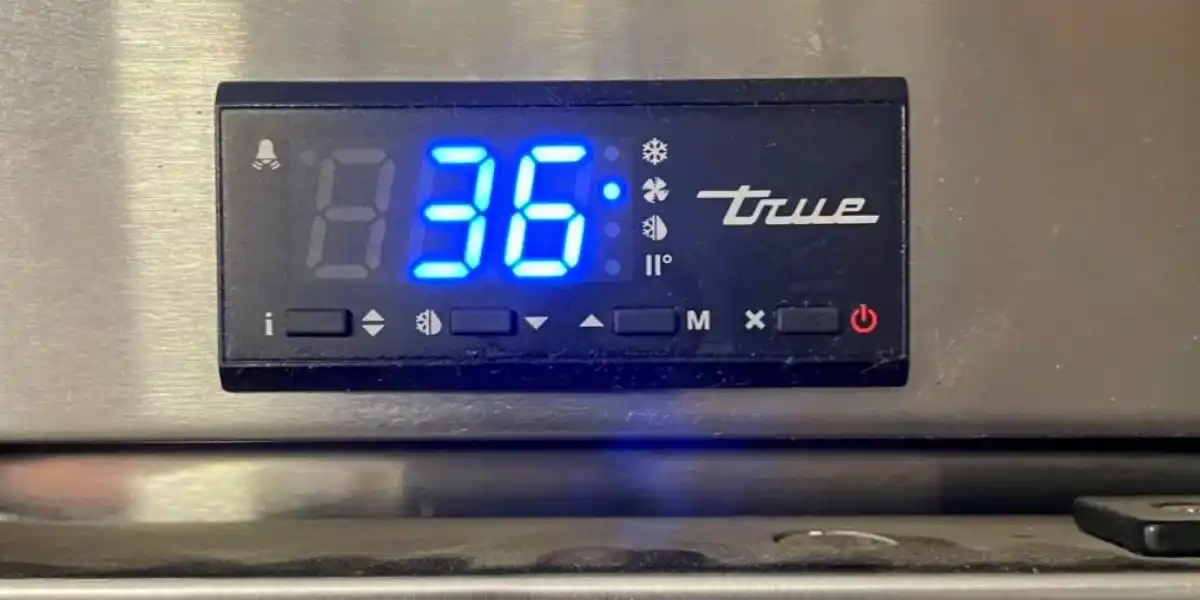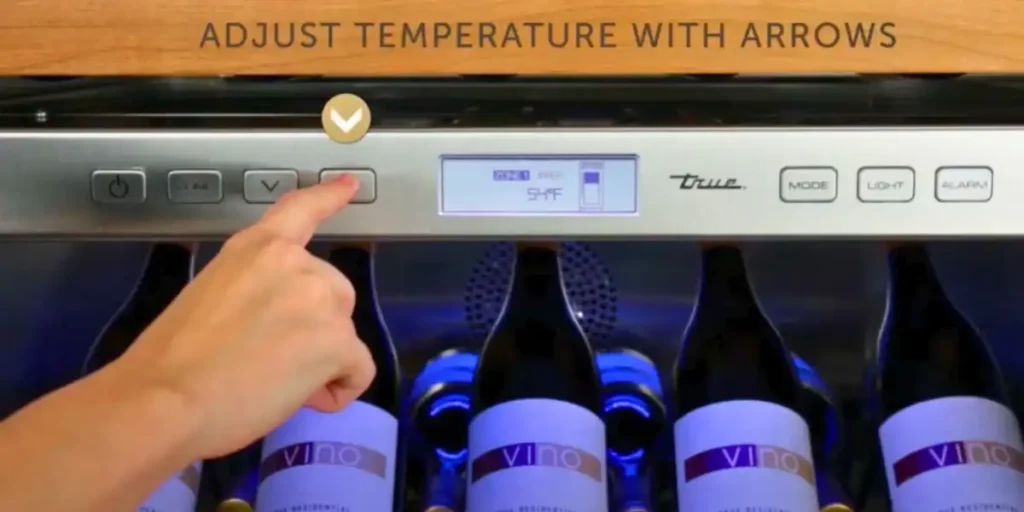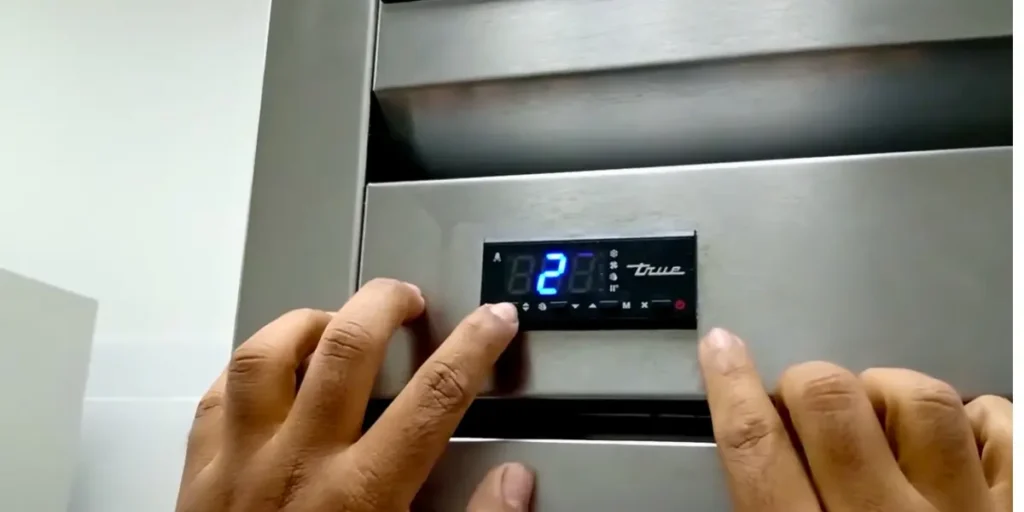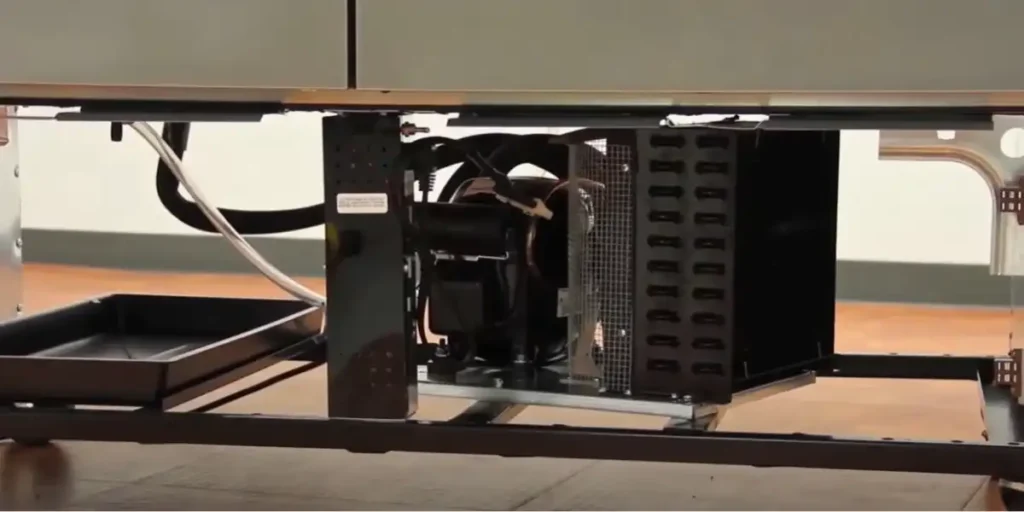True Commercial Refrigerator Temperature Control Settings
We may earn affiliate fees for purchases using our links (at no additional cost to you).
Setting the right temperature for a true commercial refrigerator is crucial to ensure the safety and freshness of perishable items.
In this article, we will explore the ideal settings, how to adjust the temperature, and various factors that can influence the temperature in a true commercial refrigerator.

What Are the Ideal Settings for a True Commercial Refrigerator?
For most food businesses, setting the temperature between 36°F and 38°F (2°C and 3.3°C) is recommended.
This range ensures that perishable goods remain fresh and free from the risk of freezing.
The Food and Drug Administration (FDA) mandates that commercial refrigerators should be set at or below 40°F (4.4°C) to maintain food safety. However, a slightly lower temperature range is preferable for the best results.
How Do You Adjust the Temperature in a True Commercial Refrigerator?
To maintain the ideal temperature in your true commercial refrigerator and ensure the freshness and safety of your stored items, follow these simple yet crucial steps:
Step 1: Locate the Control Panel
The control panel is your gateway to adjusting the refrigerator’s temperature. It is typically situated on the interior of the unit, strategically placed for easy access.
On this panel, you will find important information such as the current temperature setting and various control options.
Step 2: Access the Temperature Adjustment Mode
To access the temperature adjustment mode, simply follow the manufacturer’s instructions.
Depending on your refrigerator model, this may involve pressing a designated button or accessing a menu on the control panel.
Entering this mode allows you to make precise adjustments to the internal temperature.
Step 3: Set the Desired Temperature
With the temperature adjustment mode engaged, use the provided controls (often represented by up and down arrows or a touch screen) to set the temperature to the recommended level of 38°F or 3.3°C.
Be attentive to the units displayed (Fahrenheit or Celsius) to ensure the correct temperature measurement.
Step 4: Allow for Stabilization
Temperature adjustments take time to take effect. After setting the desired temperature, it’s essential to be patient and allow the refrigerator time to stabilize at the new setting.
Refrigerators are sophisticated cooling systems, and fluctuations in temperature can be expected during this period of adjustment.
Allow several hours for the refrigerator to reach and maintain the desired temperature consistently.
Step 5: Regular Monitoring
Consistent monitoring of the refrigerator’s temperature is a must to ensure it stays within the desired range.
Rely on a separate, reliable thermometer to verify the readings shown on the control panel.
Make it a routine to check the temperature at least twice a day, particularly during peak business hours when the refrigerator is most active.
Factors Affecting the Temperature of a True Commercial Refrigerator

There are several key factors that can influence the temperature of a true commercial refrigerator, and it’s essential to address them to maintain optimal cooling efficiency:
Dirty Condenser Coils
Condenser coils are crucial components responsible for cooling the refrigerant, which provides cold air for the fridge.
Accumulated dirt, dust, and grease on these coils can hinder their proper function, leading to warmer temperatures inside the refrigerator. This rise in temperature can potentially result in food spoilage.
Faulty Doors
The refrigerator’s doors play a critical role in preserving the cold air and keeping warm air out. A tight seal is formed every time the doors are closed, ensuring proper cooling.
However, if there is damage to the doors or the rubber gasket, the seal may fail, leading to temperature inconsistencies.
Rusty or damaged door hinges can also hinder the doors from closing correctly, further compromising the cooling efficiency.
Faulty Thermostat
The refrigerator’s thermostat is responsible for measuring the internal temperature. If it malfunctions and fails to read temperatures accurately, the fridge might display safe temperatures while actually being too warm.
For commercial refrigerators, the ideal temperature is typically set at 38°F. A malfunctioning thermostat can lead to potential food spoilage, as the temperature readings become unreliable.
Compressor Failure
The compressor’s role is to condense the refrigerant before it enters the condenser coils. If the compressor is failing, the refrigerator won’t cool efficiently, and temperatures may rise.
Signs of a failing compressor include loud noises or continuous running of the fridge. It is crucial to address compressor issues promptly by either repairing or replacing them to avoid the fridge becoming too warm.
Incorrect Temperature Settings
Sometimes, the perceived warmth inside the fridge may be due to incorrect temperature settings.
It’s essential to check the temperature settings and ensure they are appropriately adjusted.
If inadvertently set to the wrong temperature, simply readjusting the settings can rectify the issue and restore optimal cooling.
Blocked Circulation Vent
The circulation vent is responsible for allowing cold air to flow throughout the refrigerator, maintaining a consistent temperature.
However, if this vent becomes blocked by food or containers, it can create warm spots inside the fridge.
Ensuring the circulation vent remains clear and unobstructed is vital for efficient cooling and temperature regulation.
What Happens If Your True Commercial Refrigerator Temperature Settings Are Incorrect?

1. Food Spoilage
If the refrigerator is too warm due to incorrect temperature settings, perishable food items become vulnerable to spoilage.
Bacteria and other microorganisms thrive in higher temperatures, accelerating food decomposition and leading to potential health hazards.
2. Compromised Freshness
Incorrect temperature settings can compromise the freshness of stored goods. Fruits, vegetables, and dairy products may wilt or curdle, affecting their taste and texture.
3. Health Code Violations
For businesses that deal with food storage, maintaining the proper temperature in commercial refrigerators is essential for compliance with health and safety regulations.
Failure to adhere to these standards can lead to fines, penalties, or even closure of the establishment.
4. Increased Energy Consumption
When the temperature settings are too low, the refrigerator works harder to maintain the colder temperature, leading to higher energy consumption and increased utility costs.
5. Wastage of Food and Money
Food that has been exposed to improper temperatures and subsequently spoiled must be discarded, resulting in financial losses for the business.
6. Unsafe Food Practices
Inaccurate temperature settings can give a false sense of security, leading to the use of potentially unsafe food without proper refrigeration.
7. Negative Impact on Reputation
If customers encounter subpar food quality or safety concerns due to incorrect refrigerator temperatures, it can damage the reputation of the business and deter repeat customers.
8. Foodborne Illness Outbreaks
In the worst-case scenario, incorrect temperature settings can create an environment conducive to the growth of harmful bacteria, leading to foodborne illnesses among consumers.
Tips for Maintaining Your True Commercial Refrigerator
Regular Cleaning and Defrosting
Keep your True commercial refrigerator in top-notch condition by regularly cleaning and defrosting it.
Wipe down the interior surfaces with a mild detergent to remove any spills or food residues.
Defrosting should be done when ice build-up reaches around 1/4 inch to ensure efficient cooling and prevent frost accumulation.
Check and Replace Gaskets
Inspect the door gaskets of your True commercial refrigerator for signs of wear or damage.
Replace any worn-out gaskets to maintain proper sealing and prevent energy wastage.
Tight door seals ensure that your refrigerator runs efficiently, reducing electricity costs.
Monitor Temperature Settings
Maintain the correct temperature inside your True commercial refrigerator by regularly monitoring the thermostat settings.
Optimal temperatures ensure food safety and prevent spoilage. Refer to the manufacturer’s guidelines for the recommended temperature range for your specific model.
Keep It Well-Organized
Organize the contents of your True commercial refrigerator logically. Categorize items and place them in designated areas.
This not only makes it easier to find things but also reduces the time the door is open, leading to energy savings.
Proper Air Circulation
Ensure there’s adequate space around your True commercial refrigerator for proper air circulation.
Allow at least 2-3 inches of space between the refrigerator and the walls to prevent overheating and help the condenser work efficiently.
Regularly Inspect and Clean the Condenser Coil

The condenser coil of your True commercial refrigerator plays a crucial role in cooling. Inspect and clean it at least twice a year to remove dust and debris.
A clean coil improves cooling efficiency and extends the refrigerator’s lifespan.
Address Issues Promptly
If you notice any unusual noises, temperature fluctuations, or water leaks, address them promptly.
Ignoring these signs could lead to more significant problems and costly repairs. Contact a professional technician to diagnose and fix the issue.
Energy-Saving Features
Make the most of the energy-saving features of your True commercial refrigerator. Some models have LED lighting and energy-efficient compressors.
Utilize these features to minimize energy consumption and reduce utility bills.
Regular Maintenance Schedule
Create a regular maintenance schedule and stick to it. Having a structured plan for cleaning, inspecting, and maintaining your True commercial refrigerator ensures its longevity and peak performance.
Keep the Exterior Clean
Don’t forget to clean the exterior surfaces of your True commercial refrigerator. Wipe down the doors, handles, and control panel regularly with a gentle cleaning solution to keep it looking good and free from dirt and fingerprints.
FAQs about True Refrigerator Temperature Control
Can I set my true commercial refrigerator below 38°F to keep items even colder?
How often should I check the refrigerator’s temperature?
Does the refrigerator’s location in my establishment affect its temperature?
Can I use the refrigerator’s built-in thermometer for accurate readings?
How can I extend the lifespan of my true commercial refrigerator?
Conclusion
Maintaining the ideal temperature in your true commercial refrigerator is crucial for the success of your business.
By adhering to the recommended setting of 38°F or 3.3°C, you can ensure that your perishable items remain fresh and safe.
Remember to adjust the temperature using the refrigerator’s control panel and consider the factors that can influence its performance, such as sensor location, door openings, and ambient conditions.
In the event of incorrect temperature settings, be aware of the potential consequences, such as food spoilage, freezing, and increased energy costs.
Regular monitoring and prompt adjustments will help mitigate these issues and keep your refrigerator operating efficiently.
